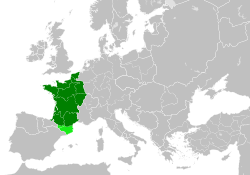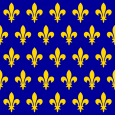
Back فرنسا في العصور الوسطى Arabic Сярэдневяковая Францыя Byelorussian Francia en la Edad Media Spanish Keskaegne Prantsusmaa Estonian فرانسه در قرون وسطی Persian France au Moyen Âge French An Fhrainc sna Meánaoiseanna Irish צרפת בימי הביניים HE Prancis Abad Pertengahan ID Francia medievale Italian
This article has multiple issues. Please help improve it or discuss these issues on the talk page. (Learn how and when to remove these template messages)
|
Kingdom of France Reaume de France Royaulme de France | |||||||||
|---|---|---|---|---|---|---|---|---|---|
| |||||||||
Motto:
| |||||||||
 The Kingdom of France in 1000 | |||||||||
 The Kingdom of France in 1190. The bright green area was controlled by the so-called Angevin Empire. | |||||||||
| Capital | Paris | ||||||||
| Common languages | |||||||||
| Religion | Roman Catholicism | ||||||||
| Government | Feudal monarchy | ||||||||
| King of France | |||||||||
| Legislature | Estates General (since 1302) | ||||||||
| Historical era | Middle Ages | ||||||||
• Beginning of Capetian dynasty | 987 | ||||||||
| 1337–1453 1422 | |||||||||
| c. 15th century | |||||||||
| Currency | |||||||||
| ISO 3166 code | FR | ||||||||
| |||||||||
| History of France |
|---|
 |
| Topics |
| Timeline |
|
|
The Kingdom of France in the Middle Ages (roughly, from the 10th century to the middle of the 15th century) was marked by the fragmentation of the Carolingian Empire and West Francia (843–987); the expansion of royal control by the House of Capet (987–1328), including their struggles with the virtually independent principalities (duchies and counties, such as the Norman and Angevin regions), and the creation and extension of administrative/state control (notably under Philip II Augustus and Louis IX) in the 13th century; and the rise of the House of Valois (1328–1589), including the protracted dynastic crisis against the House of Plantagenet and their Angevin Empire, culminating in the Hundred Years' War (1337–1453) (compounded by the catastrophic Black Death in 1348), which laid the seeds for a more centralized and expanded state in the early modern period and the creation of a sense of French identity.
Up to the 12th century, the period saw the elaboration and extension of the seigneurial economic system (including the attachment of peasants to the land through serfdom); the extension of the Feudal system of political rights and obligations between lords and vassals; the so-called "feudal revolution" of the 11th century during which ever smaller lords took control of local lands in many regions; and the appropriation by regional/local seigneurs of various administrative, fiscal and judicial rights for themselves. From the 13th century on, the state slowly regained control of a number of these lost powers. The crises of the 13th and 14th centuries led to the convening of an advisory assembly, the Estates General, and also to an effective end to serfdom.
From the 12th and 13th centuries on, France was at the center of a vibrant cultural production that extended across much of western Europe, including the transition from Romanesque architecture to Gothic architecture and Gothic art; the foundation of medieval universities (such as the universities of Paris (recognized in 1150), Montpellier (1220), Toulouse (1229), and Orleans (1235)) and the so-called "Renaissance of the 12th century"; a growing body of secular vernacular literature (including the chanson de geste, chivalric romance, troubadour and trouvère poetry, etc.) and medieval music (such as the flowering of the Notre Dame school of polyphony).


